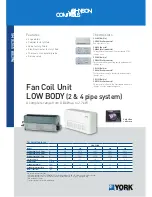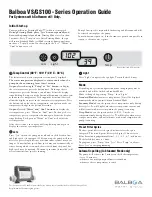
www.hotwater.com
29
or any region that experiences hot summers. Ambient
conditions hotter than 110°F (43°C) require that the venting
material be either CPVC or polypropylene. Areas that can
experience high ambient environments include closets,
alcoves, areas under staircases, attics-especially in metal
roofed buildings, areas with restricted air movement,
rooms with large solar gains, metal sheds, industrial or
commercial enterprises and venting systems exposed to
direct sunlight. For high temperature environments, obtain
high limit switch upgrade Kit # 9008306015 and use the
higher rated vent piping.
Note:
This unit can be vented with the following piping:
PVC pipe
materials
DWV ASTM-D2665
Schedule 40, 80* & 120* ASTM-D1785,
SDR Series ASTM-D2241
CPVC pipe
materials
CPVC 41 ASTM-D2846
Schedule 40, 80* & 120* ASTM-F441
SDR Series ASTM-F442,
ABS pipe
materials
DWV ASTM-D2661
Schedule 40
Polypropylene
vent system
UL-1738
* NOTE:
USING SCHEDULE 80 OR 120
SIGNIFICANTLY REDUCES THE VENT LENGTH.
Note:
If local codes require venting to be marked suitable
for use as gas venting, type BH venting may be used.
The fittings, other than the Termination should be
equivalent to:
PVC pipe
PVC DWV ASTM D-2665
CPVC pipe
CPVC ASTM F-438
ABS pipe
ABS ASTM D-2661/3311
Polypropylene
vent system
UL-1738
If CPVC or ABS pipe and
fi
ttings are used, the proper
cement must be used for all joints, including joining the
pipe to Termination (PVC Material). If local codes do not
allow the use of the PVC termination when a material
other than PVC is used for venting, an equivalent
fi
tting of
that material may be substituted if the screen in the PVC
terminal is removed and inserted into the new
fi
tting.
This water heater is supplied with a 45 degree PVC
termination elbow and the applicable vent screens. A 90
degree termination elbow is optional.
ASTM D-2564 Grade Cement should be used on PVC
Materials and ASTM F-493 Grade Cement on CPVC
Materials.
POLYPROPYLENE VENT SYSTEMS
Polypropylene vent systems do not use cement to connect
the pipe and elbow sections but use a push together gasket
seal method. Do not attempt to connect polypropylene
with sealant cement.
Polypropylene vent systems are designed to use speci
fi
c
adaptors to connect into the rubber coupling on the top
of the blower. Thse are available through your venting
supplier.
The PVC vent termination elbow supplied with this heater
has been certi
fi
ed to be used with polypropylene vent
systems. A polypropylene to PVC end connection is
required and is available through your supplier.
Optional wall plates that
fi
t the polypropylene venting are
also available through your supplier.
Carefully inspect the entire venting system for any signs of
cracks or fractures, particularly at joints between elbows
and other
fi
ttings and straight runs of vent pipe. Check
system for signs of sagging or other stresses in joints as
a result of misalignment of any components in the system.
If any of these conditions are found, they must be corrected
in accordance with the venting instructions in this manual
before completing installation and putting the water heater
into service.
The vent piping shall be connected to the blower with
the rubber coupling and secured with gear clamps. The
coupling and clamps are provided with the heater.
Even though the
fl
ue gas temperature leaving the blower
is hot, some installations will have water condense in
the vent piping. If this occurs, then adequate means of
draining and disposing of the condensate shall be made
by the installer.
CONDENSATE
Condensate formation does not occur in all installations
of power vented water heaters, but should be drained
on installations where it can form in the venting system.
Condensation in the venting system of power vented
water heaters is dependent upon installation conditions
including, but not limited to, ambient temperature and
humidity of installation location, ambient temperature
and humidity of venting space, vent discharge and slope,
and product usage. In certain conditions, installations in
unconditioned space or having long horizontal or vertical
vent runs can accumulate condensate. Long lengths of
venting that pass through cool/cold areas will experience
condensation. The vent pipe should be sloped upwards
away from the blower assembly, then adequate means
for draining and disposing of the condensate needs to
be made by the installer. If installation conditions cause
condensation, install a condensate trap loop approximately
8 in. (200mm) in diameter using 3/8” plastic hose. Connect
the hose to the built-in drain port of the rubber coupling
of the blower assembly (see Figure 30). Loop the hose
in a vertical position as shown. The tube loop must be
fi
lled with water at least half way prior to operating the
heater. Ensure the end of the tube has access to a drain
as condensate will
fl
ow from the end. Secure the tubing to
the side of the heater. Prior to operating the water heater,
make sure the removable cap is installed on the drain port
(if a drain hose is not needed).
Note:
This cap must remain in place if a drain hose is not
installed.
















































